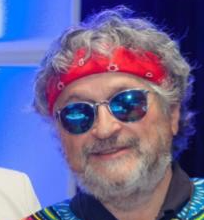
It was late in the Fall of 1968, at the same time that George Brown College was welcoming its first students, that Howard was hired to teach ESL by the Toronto Board of Education. And early in 1969 George Brown incorporated the ESL and many other programmes from the Board as the College evolved into an important, downtown post secondary institution.
As an Associate Master at the newly formed, expanding College, Howard taught upgrading (BTSD) at the College St. campus until he was transferred to the not-quite-completed Casa Loma campus in 1971. From here he taught everything from English to a class of Manpower Programme parolees to Sociology to nursing students out at St. Joseph’s School of Nursing in the city’s west end. Through it all he was attracted to the possibilities of using technology in his teaching...a little wary but attracted. (He was the first in his office who could manually thread a 16 mm projector in under 30 seconds.)
After all, Bill Davis, Minister of Education who had put together the College system in Ontario advocated use of the latest technology: “Educational Television should be developed to the maximum: open circuit, with the employment of the video-tape recorder to preserve publicly televised programs for use within the College timetable; closed circuit, to enhance instruction, and to cope with the weight of numbers.”
The College continued to grow. One night in the 80’s Howard went to sleep an Associate Master but awoke a Professor and bought his first personal computer soon after. The age of the personal computer in education had begun. As the College was extending itself to serve international students, he used a forerunner of Collaborate on GBC’s first LMS, WebCT, to teach a course for denturist students living in such far flung sites as Seattle, Johannesburg, and Las Vegas
His interest in technology was eventually focused in the late ‘90’s and early 2000’s on creating a course called the ‘History of Technology’ which he lovingly developed, revised, deconstructed, threatened to dump, revamped and offered in many guises over the next 20 years.
Being neither a technophile nor a technophobe, Howard has tried to familiarize himself with “the latest” without compromising his critical sense. He is constantly asking himself, after the novelty has worn off, whether the ‘latest and greatest’ is really a step forward in the teaching and learning exchange. How is it benefiting student learning? How is it aiding him as a teacher?
He is currently experimenting with a number of exciting projects in educational technology: the inclusion of a video game, ‘Adventures Along the Silk Road’ developed in conjunction with the Game Programming department; a virtual reality segment for the in-class delivery of his course, developed with the help Ian Crane of TLX; and the use of various and sundry software programmes in the asynchronous online and face-to-face hybrid versions of his course with help from Adeesha Hack, the TLX representative for LAS.
